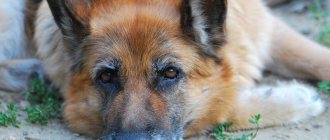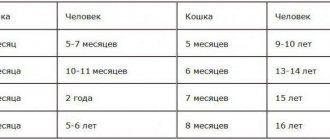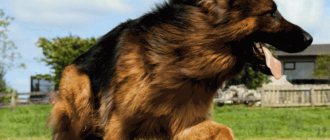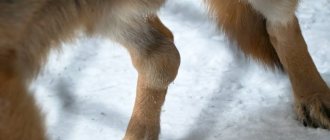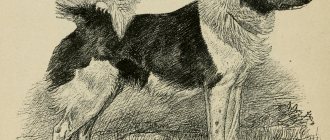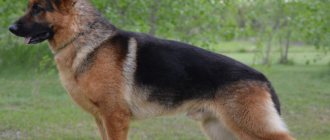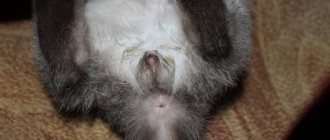Rickets in dogs is a disease of individuals under one year of age, regardless of breed, which is characterized by impaired bone formation and skeletal deformation. It can also occur in adult dogs, but is extremely rare. As a rule, there will be talk about osteomalacia. All this is a consequence of metabolic disorders due to a lack of vitamin D (this includes ergocalciferol D2 - cholecalciferol - D3, etc.).
If you think that you can just start feeding your dog more vitamins and all your problems will be solved, then you are mistaken. This vitamin is not so simple, and the cause of the disease may lie deeper than it seems. Vitamin D itself in its pure form has no effect on the development of rickets. Now let's figure it all out.
Description of the disease
The elements that are responsible for healthy bone development are calcium and phosphorus, the absorption of which is carried out under the influence of the active form of vitamin D2 and D3. Thus, rickets develops when the metabolism of calcium and phosphorus is disturbed. These elements must be supplied with food in the required quantities.
A deficiency or excess of one of these substances is detrimental to the body. Normally, the ratio between calcium and phosphorus should be from 1.5:1 to 2:1, respectively.
Vitamin D is fat soluble, meaning it will not be absorbed without sufficient fat in the diet. Vitamins of group D are activated only under the influence of ultraviolet rays: sunlight or artificial UV radiation. Form D2 is formed under the influence of radiation in products of plant origin and enters the dog’s body with food. And D3 is synthesized under the influence of ultraviolet rays directly in the body.
It is the D3 form that is most actively involved in the absorption of the amount of calcium needed by the body, and therefore fights rickets.
Causes of rickets
Insufficient intake of provitamins D (vitamin precursors from which active forms are formed) from food. Because of this, the necessary micro- and macroelements are not absorbed.
Lack, excess or incorrect ratio of calcium and phosphorus in the diet.
Lack of sunlight. If the dog is constantly in a closed enclosure, or is kept exclusively in an apartment.
Excessive or insufficient amounts of fats, proteins, carbohydrates, vitamins and microelements (iron, copper, iodine, etc.) supplied with food. A disruption in the supply of these components entails a failure in the entire metabolism. And for a growing puppy’s body, this is a threat to bone formation - rickets.
If a puppy gets an infectious disease, such as plague, or any inflammatory process in the body, from bronchitis to enteritis, also entails metabolic disorders. And, as a result, rickets develops.
Newborn puppies mainly receive the necessary elements from colostrum and mother's milk. If you are feeding your newborn puppy with artificial milk replacers, you should make sure that they contain D3 and other necessary elements. Artificial cultivation is a common cause of the development of rickets.
Causes
A chronic disease such as rickets can be caused by genetic inheritance due to disorders at the cellular level in the ancestors of the German Shepherd puppy.
If the dog’s feeding regimen initially includes insufficient amounts of phosphorus and calcium, the puppy will develop rickets very quickly. Do not forget that excess phosphorus reduces the amount of calcium in the body. If you are not familiar with the rules for the correct balance of vitamins and minerals in the diet, read the article “Vitamins for German Shepherds.”
If the functions of the thyroid gland are impaired, calcium and phosphorus do not reach the bones of the dog’s skeleton in the required amount.
Vitamin D, as well as fish oil, contribute to the proper absorption of calcium by the body of a German Shepherd puppy. The lack of this vitamin occurs due to a failure of biosynthesis reactions in the skin, fiber under the skin, and liver.
Vitamin D is found in fermented milk products, cottage cheese, cheese, vegetable oil, fish oil, seafood, and some herbs. Also, this fat-dissolving vitamin can be produced in the dog’s skin under direct sunlight.
If the puppy grows up in conditions unsuitable for keeping and proper physical development - in a damp and dark room - then the disease will begin to progress from the first months of the baby’s life.
Symptoms of rickets
In the initial stage:
- The puppy seems “lethargic”, but the general condition can be described as satisfactory.
- The quality of the coat deteriorates, the skin is dry and less elastic.
- Appetite decreases or a perversion of appetite develops, with the puppy licking or even trying to eat inedible objects. This can sometimes be seen as puppies licking each other, so you may think it's cute, but it may be a warning sign and you should keep a close eye on your puppies.
- Constipation or diarrhea may indicate a metabolic disorder.
- Tense gait, rapid and frequent stepping from paw to paw.
- Fractures, and spontaneous ones.
- Lameness.
In severe stages:
- The puppy behaves apathetically, tries to lie down as long as possible and not get up.
- The wool is matte, very poor quality. The skin is dry and inelastic.
- A child with rickets is noticeably behind in growth compared to his peers of the same age.
- Appetite is sharply reduced or distorted. It manifests itself more strongly than in the initial stage, in this case the dog can eat soil, rags, paper, and coprophilia develops (when the dog eats feces).
- Due to the symptoms described above and metabolic disorders, gastritis and other problems with the gastrointestinal tract develop.
- Diarrhea alternates with constipation.
- Due to softening of the bones, deformations are observed. The spine sags under the weight of the muscles. It turns out that the spine is curved downward, this is called lordosis. The limbs, usually clearly marked on the front legs, bend inward or outward, thus taking the shape of the letter “O” or “X”. The costal processes become soft. You can feel the so-called “rosary” on the dog’s ribs. The last caudal vertebrae may be resorbed.
- Teeth may fall out.
- The dog is rapidly losing weight, and the body is exhausted.
Symptoms of rickets in dogs
In the early stages, identifying the disease is problematic, since the symptoms are invisible. However, the first visible clinical signs of rickets in young dogs appear quite quickly. The body grows rapidly, if the metabolism of vitamins and minerals is disrupted, uncharacteristic changes in the pet’s appearance should worry the owner.
The main signs of pathology in an animal:
- The puppy gets tired faster than usual.
- The gait gradually becomes cautious.
- Over time, lameness appears.
- The general appearance of the pet changes - the fur becomes disheveled and dull.
- The appetite is most often increased, plus the dog may have a desire to eat something unusual (plaster, gravel).
- Unformed feces with remnants of undigested food.
- Constipation may occur periodically and resolve on its own.
Directly from the musculoskeletal system, rickets manifests itself specifically:
- Thoracic limbs: Paws are curved, in later stages turned outward or inward. When walking, the dog does not rely on its toes, but entirely on its pastern (an unnatural position).
- Pelvic limbs: in the area of the hock joint, turned inward or outward. There is a general weakness of the hind legs with rickets.
- The spine is slightly hunched.
- Round growths, like rosary beads, can be felt on the ribs. The costal arch is strongly pronounced, the bones themselves are fragile and emaciated.
- When you feel the bone skeleton of the paws, irregularities are felt. The bones are thin or, conversely, with uneven thickenings - the so-called “bracelets”.
- The muscles on the affected limbs develop poorly.
- The change of teeth is disrupted, and in adult pets teeth fall out.
- Bones become brittle.
- In advanced conditions, the eyes become sunken, there is a general exhaustion, convulsions, and trembling.
When a dog develops even mild symptoms of rickets, treatment for the pathology begins immediately. The disease causes a number of inconveniences to the pet and negatively affects the functioning of internal organs and the entire body.
Treatment
In puppies, if you start treatment on time, you can achieve one hundred percent success!
Diagnostics
An external examination is not enough to make a diagnosis, although it already says a lot. A competent doctor collects information about the puppy’s care—analyzes the dog’s diet and exposure to sunlight or the presence of artificial ultraviolet radiation.
It is necessary to conduct laboratory blood tests. With vitamin D deficiency in the blood, the following is found:
- lack of calcium and phosphorus;
- increased activity of the enzyme Alkaline Phosphatase (ALP);
- reserve alkalinity changes;
- increased acidity in the blood (ph);
- with an exacerbation of the inflammatory process, an increase in leukocytes is detected in the blood, namely neutrophils - neutrophilic leukocytosis;
- hypochromic anemia (lack of chromium) may occur;
An x-ray will also need to be taken.
First aid
The first thing you should do for your pet is to go to a veterinarian who will confirm the diagnosis of rickets and prescribe you the necessary medications. Do not self-medicate.
Drugs
Treatment must be comprehensive. It is necessary to adjust feeding, living conditions and introduce vitamin and mineral supplements. The use of the following drugs is recommended:
- Ergocalciferol (the dosage and regimen of this drug is prescribed individually, depending on the stage and type of disease).
- Tetravit, retinol, and others.
- Mineral supplements: calcium gluconate, bone and meat and bone meal, fish oil (25 - 30 ml), tricalcium phosphate and others.
- Calcium supplements, such as Brevex.
If left untreated, the disease will definitely not go away on its own, and the dog will eventually become disabled. Skeletal deformation will eventually begin to interfere with the normal functioning of the circulatory, respiratory and other internal systems of the body, which invariably leads to death.
Treatment of rickets in dogs at home
Rickets is a disease that does not kill. However, if the developing pathology is not treated, it will inevitably lead to the dog’s disability. Service breeds with a similar diagnosis cannot be used for their intended purpose; decorative breeds are not allowed for exhibitions. The deformed skeleton begins to put pressure on internal organs, provoking the development of various chronic diseases; the pet’s gait changes, lifelong lameness appears, and its appearance changes. Dogs with rickets that was not treated in childhood are more susceptible to fractures and often experience pain when walking or simply when touching the chest, croup, or limbs.
Fortunately, the treatment of rickets, especially in the early stages, is quite successful, and the main therapy can be carried out at home, provided, of course, that its course is prescribed by a veterinarian after a thorough examination of the animal.
We advise you to read why a dog grunts, wheezes and chokes, and what to do about it.
With the help of drugs
Currently, veterinary practice considers only two specific medications as an effective treatment for rickets in dogs - Artroglycan and Calcidee.
Their main characteristics are shown in the table:
| Description | Artroglycan | Calcidi |
| Composition (active ingredient) | Chondroitin sulfate, glucosamine hydrochloride (isolated from shark cartilage); tocopherol, calcium gluconate, selenocystine, selenomethionine | Dicalcium phosphate, cholecalciferol (vitamin D), magnesium stearate, silicate, stearic acid |
| Physiological properties | Replenishes calcium, selenium and vitamin D deficiency, promotes the formation of bone and cartilage tissue, improves bone saturation with calcium | Calcium, phosphorus and vitamin D preparation in required proportions |
| Indications | Treatment of rickets and other degenerative pathologies of joints and skeleton, arthrosis, osteochondrosis, arthritis, osteoporosis, joint dysplasia | Treatment and prevention of rickets in puppies, supplement to the diet of pregnant and lactating bitches |
| Dosage | 1 tablet per 10 kg of weight | For puppies - 0.5 tablets per day; pregnant and lactating bitches - from 2 to 6 tablets per day, depending on the size of the animal |
| Contraindications | Individual intolerance | Not identified |
| Side effect | Allergic reaction (rare) | Allergic reaction (rare) |
| Advantages | Does not contain other vitamins and microelements, except those necessary for the treatment or prevention of rickets, which makes the medicine universal and allows it to be combined with other drugs |
Since the disease is essentially functional and not infectious in nature, no other special medications (antibiotics, antispasmodics, diuretics, corticosteroids, analgesics, antihistamines, anti-inflammatory drugs, etc.) are required for its treatment.
How to feed your dog correctly
The dog's diet during treatment should be complete and balanced. It is very important that the pet’s diet, if it eats natural food, contains raw meat, the yolk of chicken or quail eggs, dairy products, as well as the carbohydrate part - cereals. It is much easier to ensure that all necessary vitamins and microelements are included in the diet if you use ready-made food selected by a veterinarian.
Important! When including vitamin and mineral supplements in a dog’s diet, you need to remember that all these elements are already present in certain quantities in natural products, and in some foods they are, as a rule, quite sufficient for the normal development of the animal.
If special preparations of calcium and phosphorus, as well as vitamin D are not used in the prescribed course of therapy, various vitamin supplements or natural products rich in the three indicated components, as well as other important elements necessary for the formation of a healthy musculoskeletal system, can be used as an alternative. For example:
- fish fat;
- bone flour;
- calcium gluconate;
- glucosamine chondroitin;
- food supplements such as “SA-37”, “Kostochka”, “Polivit-calcium”, “Doctor Zoo”, “Vittri”, “Trivitamin”, etc.
Nutrition and care
Plays a key role in the dog's recovery. The puppy should be kept in a bright and dry room. He just needs long walks in the fresh air and always under the sun. If this is not possible, artificial UV irradiation procedures using quartz lamps should be prescribed.
The feed should be easily digestible and contain the required amount of calcium and phosphorus. D3 must be present in the diet.
If you feed your dog “natural” food, you must introduce the following products:
- calcined cottage cheese;
- fresh meat;
- vegetables, especially carrots;
- eggs;
- chalk.
If you stick to commercial food, you may need to change the food, which has a composition of vitamins and minerals that is more suitable for removing the body from a pathological condition.
Methods of therapy - rickets in puppies
Treatment of rickets begins immediately. It consists of replenishing the deficiency of vitamin D, as well as calcium and phosphorus. Vitamin D preparations, fish oil, calcium salts, vitamins A, C, B1 are prescribed.
You need to walk your puppy a lot in the fresh air so that he receives healing ultraviolet rays. The most optimal period is from 9 to 11 o'clock. Strong exercise and walks will strengthen the dog’s muscles and help the animal’s weakened bones. Young animals need to exercise a lot to develop properly. It is not necessary to tire the puppy; the main thing here is not to overdo it with stress.
Treatment with a quartz lamp under the supervision of a physician can also be used. Irradiation begins from 2-3 minutes and is increased to 20 minutes, protecting the dog’s eyes and genitals. The course of treatment lasts 15-20 days.
Risk group
Any dog can get sick, regardless of breed. Mostly puppies get sick, but there are cases when rickets affects adults, in which case everything is more complicated.
At risk:
- Large breed dog puppies. The fact is that babies of large breeds grow very quickly, and bone tissue does not have time to develop. Therefore, their nutrition needs to be monitored especially carefully and vitamin-mineral complexes introduced.
- Dogs kept in unfavorable conditions or in dark enclosures without walking are certainly susceptible to hypovitaminosis, and as a result, rickets.
- Puppies born from a mother who did not receive sufficient balanced nutrition during pregnancy.
- Puppies fed on low-quality milk replacers.
- Individuals who have recovered from infectious diseases (plague) or other diseases that have adversely affected their metabolism.
- If the dog does not receive a balanced diet, he is definitely at risk.
Prevention
- The basis of prevention is timely visits to the veterinarian and vaccination.
- Monitor the development of your little pet.
- Balanced feeding. When feeding a dog natural food, vitamin and mineral supplements are necessary. And dry food must be premium and super-premium, in other words, with a guarantee of quality. And make sure that the composition contains D3 or cholecalciferol (the name of this vitamin), as well as a sufficient amount of calcium and phosphorus in the correct 2:1 ratio.
- Sufficient access to sunlight, active walks.
What is rickets in puppies?
Rickets in puppies is a disease characterized by impaired bone formation and insufficient bone mineralization due to a deficiency of vitamin D, calcium and phosphorus during the period of the most intensive growth of the body. Vitamin D is formed in the skin under the influence of ultraviolet radiation, as well as in the subcutaneous tissue and liver. It is possible to get the vitamin from food by consuming foods such as fish oil (from cod), vegetable oils, fermented milk products, some herbs, and seafood. Vitamin D promotes the complete absorption of calcium, which is necessary for bone mineralization and is involved in many metabolic processes in the body.
Rickets is characterized by varying degrees of severity of the disease, from mild initial forms that are easy to correct to serious damage to the bone and other systems that lead to disability in the dog.
In order to recognize the development of this disease in time, let’s look at what symptoms rickets causes in puppies. If you find any signs in your pet, do not hesitate for a minute, consult a veterinarian!
FAQ
What can you do to make dogs' paws straighter?
Contact your veterinarian to confirm and identify the stage of rickets. Adjust nutrition, introduce vitamin and mineral supplements. Spend more time with your dog in the sun.
What vitamins for dogs against rickets?
Vitamins D are needed - cholecalciferol and ergocalciferol. And also, products and supplements containing calcium and phosphorus. For example, drugs Brevex, trivitamin, retinol, fish oil, etc.
What is the life expectancy of dogs with rickets?
If the puppy is treated on time, he will fully recover and his lifespan will not differ in any way from dogs that have never suffered from rickets. If an adult dog is sick, it is unlikely that it will fully recover after treatment. But with proper care, it will live its full, long life.
But if you do not take any action to cure your pet, then very soon he will become disabled. Over the course of a year, the skeleton will change beyond recognition and eventually the internal organs will be affected. Without care, such a puppy will not live to see adulthood.
Briefly about the main thing
- Rickets is a disease, mainly in puppies, caused by metabolic disorders and manifested by skeletal deformation.
- The cause of this disease may be: lack of vitamin D, incorrect ratio of calcium and phosphorus in the diet, infection with infectious diseases.
- The main symptoms of rickets: lameness, decreased motor activity, growth retardation, skeletal deformation, especially of the limbs.
- For treatment it is necessary to: adjust nutrition, add vitamins and minerals to the diet. Increase access to sunlight or organize training with artificial ultraviolet light, for example, using quartz lamps.
- At risk are large breed puppies, as well as dogs that do not receive a balanced diet and are kept in unfavorable conditions.


